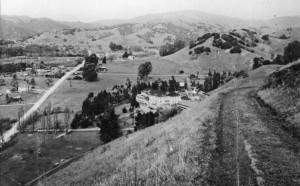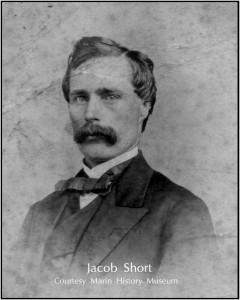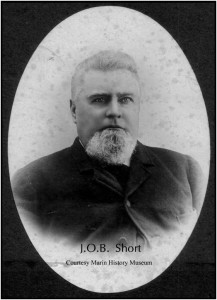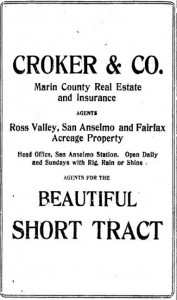The Short Ranch is San Anselmo’s largest subdivision. It encompasses much of the land north of Sir Francis Drake between Red Hill and Butterfield. It was originally part of the land grant Rancho Canada de Herrera (6,658 acres) awarded to Domingo Sais in 1839. Domingo died in 1853 and his children inherited his land.
In November 1867, George Cozzens purchased 574 acres from Domingo’s daughter Maria de la Luz and her husband Gregorio Ocania. Cozzens was related to the Sais family through his marriage to Caroline Slade, the niece of Domingo Sais. Cozzens paid $3,500 for the land and then sold it to Jacob and John Orey Baptiste (J.O.B.) Short in 1869 for $21,113.
The Short brothers came to California with their widowed mother, Jane Merriner, and two half sisters in a wagon train across the plains. They settled in San Rafael in 1847 where they occupied one of the old mission adobe buildings. The brothers leased a tract of land in Nicasio in 1853 and kept a large herd of cattle which they fattened for market. With profits from selling beef to gold miners, they purchased a large tract of land from James Ross on the south side of San Rafael, which they subdivided and called Short’s Addition. The Shorts were prominent early residents of San Rafael.
The Short brothers moved to their prosperous San Anselmo dairy ranch to a house on today’s Durham Road in the early 1880s. With them were their mother and J.O.B.’s wife Mary and their five children. Jacob never married. In 1872, he was sued for breach of promise of marriage, which must have been a hot topic for gossip in early San Rafael.
Jane Merriner died in 1892 and Jacob in 1895 at the ranch, and J.O.B. moved back to San Rafael. The 13-room ranch house was leased and was operating as a hotel or resort when it burned to the ground in 1897. Arson was suspected.
In 1898, the San Francisco Presbyterian Orphanage purchased 20 acres of the Short Ranch for the construction of their new home for orphaned children.
When San Anselmo was incorporated in 1907, Joseph K. Hawkins, attorney and son-in-law of J.O.B. Short, argued to the Marin Board of Supervisors that the Short Ranch, the Orphanage and nearby Pacheco and DuBois lands should be excluded from the town boundaries and, as ranch land, shouldn’t be taxed for municipal purposes. The supervisors agreed in part and the northern portion of the Short Ranch was excluded from the town limits. This lands remains outside the town limits today.
Surviving Short children, Orey Short and Margaret Short Hawkins, inherited the Short Ranch after their mother’s death in 1911. In 1912, they sold the ranch, plus additional acreage which the Shorts had acquired along Butterfield Road, to the Short Ranch Company, a syndicate of investors, for $100,000. Articles of incorporation were filed in February 1912. Real estate developers Fred Croker and George Raymond were the local agents for the Short Ranch Co.
Subdivision One was ready for sales in May 1912. It fronted Butterfield Road and included The Alameda, Caleta and Arroyo Avenues, and Jersey and Holstein Roads. Lots were $250 and up and acreage $350 and up. Sales at first were brisk with 10 lots sold in one week and 47 sold in the first two months. A few tracts of land were advertised as being suitable for raising chickens. Croker advertised in the San Francisco Chronicle inviting interested parties to take the 9:45 boat from San Francisco and the train to San Anselmo Station where he would meet them with his rig.
Subdivision Two, within the town limits, included San Francisco Boulevard and the surrounding streets. Lots were listed at $500 and up with acreage at $1000 and up. Easy terms were advertised.

Mostly Undeveloped Short Ranch, 1918. View to the west from Red Hill. Presbyterian Orphanage in the center.
By 1924, only a few scattered homes had been constructed. The Short Ranch Company dissolved and the remaining lots were sold to other real estate developers. Thomas Kent and Thomas Minto picked up numerous lots in Subdivision Two. They then offered seven acres to the Town of San Anselmo for $7,500 for use as a park. Memorial Park, the American Legion Log Cabin and Red Hill School(Isabel Cook) were ultimately developed on the seven acres.
The Short Ranch remained rural for many years. There were several small quarries on the ranch which produced rock used in curbs and rubble walls. Dairy cattle grazed the rolling hills at the dairies of Spagnoli and Sorich families until after WWII when an influx of new residents spurred the development of more homes. Today, Short Ranch land is preserved in Faude and Sorich Parks, Marin Open Space Preserve and undeveloped private property.




